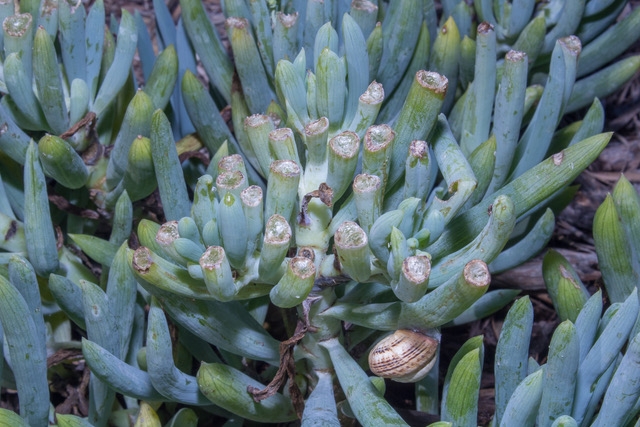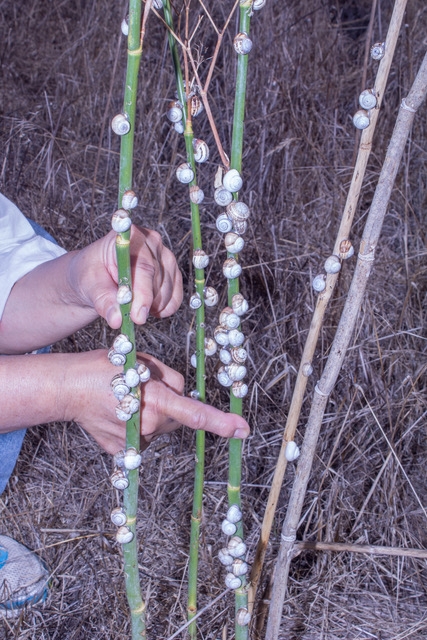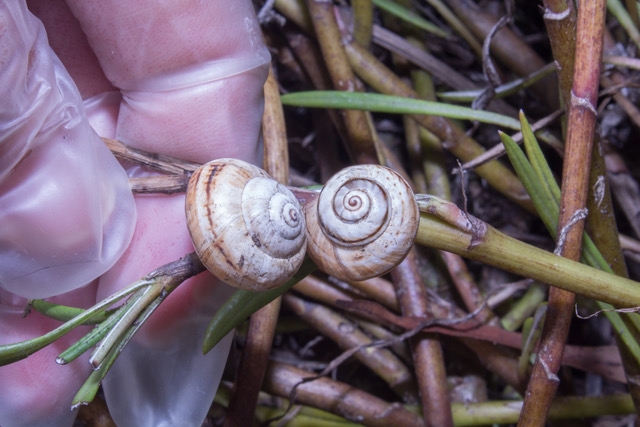Damage and Signs

Identification and Biology
The shell of this snail is unusually variable in appearance, especially in the dark bands and other markings. The adult has a medium-sized shell about the size of a nickel or dime. The non-glossy shell is typically ivory white (rarely pink), but can be light beige with narrow, dark brown bands. A similar looking but much less damaging snail, the milk snail (Otala lactea), sometimes occurs with the white garden snail and can be confused with it. The milk snail tends to be larger, up to 1.2 inches in diameter, and the inside of the thick opening is dark.
Unlike most snails and slugs, the white garden snail climbs and rests in a dormant state (estivates) on the cooler and least wind-exposed sides of vertical surfaces like trees, shrubs, fences, posts, and walls during the hot, dry season (Figure 3). They can survive for long periods by forming a wall of dry mucus to seal the shell opening and reduce water loss. They typically congregate in great numbers in an exposed, conspicuous manner to “ride out” the hot, dry season until the return of more suitable conditions in the fall.

Management
Control of the white garden snail can be time-consuming, difficult, and costly because they have a high reproductive rate, they climb high on objects, and they estivate for long periods. Effective management of this snail must rely on a combination of methods, including exclusion, early detection, and a variety of treatments.
Like most land snails, they move slowly so in order to reach new areas, they must be aided by people. To exclude the white garden snail from your area carefully check crates, boxes, and plants shipped from infested areas. To detect this snail, search plants, fences, posts, walls, and other vertical surfaces.
Measures used to manage other snails, such as sprays, baits, traps, and barriers, are only effective when the white garden snail is active and foraging on or near the ground. However, unlike other snails, this snail estivates in the open where they are visible and conspicuous, perhaps offering the best opportunity for their control; thus, hand-picking, knocking down, and then sweeping or vacuuming might be the best option, especially with limited infestations or in small landscapes. Because it can estivate in vacant fields or untended areas adjacent to landscape sites, these untended areas should be carefully checked and mowed.
For extensive details on the various management methods for the white garden snail, including habitat modification, biological control, hand-picking, and chemical control, see the full article at https://ucanr.edu/sites/HodelPalmsTrees/files/294710.pdf.
Word of Caution
Use rubber or latex gloves when picking or handling snails and vegetation with their slime trails, and wash hands thoroughly afterwards. Snails and slugs are intermediate hosts of rat lungworm disease, which is likely present but not yet officially detected in California. Rat lungworm disease is caused by a parasitic nematode that can attack the human brain and spinal cord if ingested.
[Original article published in the Summer 2020 issue of the Retail Newsletter]
